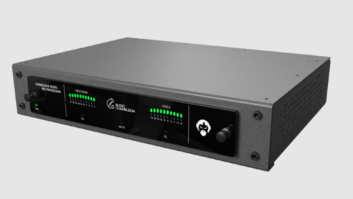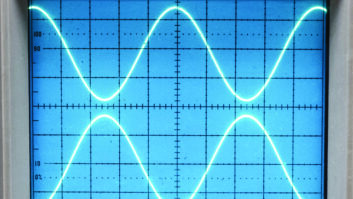(click thumbnail)When shopping for audio transmission equipment, the choices and selections can be pleasing and daunting all at once. We at NPR had such a selection to make recently. We needed equipment to deliver a dedicated audio program service reliably from a remote location over a T1 circuit. The equipment also needed a built-in backup scheme that it would smartly manage when (not if) the circuit failed.
APT offered us a look at its WorldNet Ohio model codec.
Heart of Ohio
APT’s proprietary apt-X 4:1 compression algorithm allows the user to choose a 16-bit, 20-bit or 24-bit word resolution, and apply that resolution to an appropriate transmission bitrate from 56 kbps to 576 kbps. A nice byproduct of the lossless algorithm is a published end-to-end delay of only 5 milliseconds.
Because the Ohio presents its data at a rear-panel DB-15 connector in the X.21 Data Protocol, an external Service Unit/Channel Service Unit (DSU/CSU) is needed between the Ohio and the dedicated T1 (or fractional T1) circuit.
For most North American interface equipment, the X.21 interface is converted easily to a V.35 data interface by a simple wiring change in the cable between the Ohio and the CSU/DSU. The Ohio has analog and AES/EBU digital I/O, with simultaneous audio output on digital and analog connectors. An internal sample rate converter transparently manipulates the digital input’s sample rate, as needed, to match the data network.
For backup of the primary circuit, the Ohio supports a single ISDN that can be ordered with an S/T interface for Europe or a U interface for North America. The ISDN rate is 128 kbps maximum, and the Ohio can be configured to dial the remote Ohio’s ISDN line automatically when the T1 circuit fails. When the T1 circuit is restored and stable, the Ohio switches to it and hangs up the ISDN call.
When trouble happens, the Ohio selectively triggers its alarm SPDT relays to show where the fault lies. The fault triggers are X.21 failure, Speed Dial ISDN call failure, AutoSync failure or audio silence sense. The fifth relay is a Summary Alarm, and triggers when any of the first four alarms are triggered. A front-panel LED also indicates a Summary Alarm.
Frequently, users want to send and receive triggers between local and remote sites, and the Ohio accommodates this by repurposing its first four alarm relays for signaling. The remote Ohio’s relays are selectively closed or opened by pressing the front-panel buttons on the local Ohio unit, or more impressively, feeding a mix of up to four DC (+5 to -30 volts), or Normally Open or Normally Closed contacts into a rear-panel DB15 connector.
In actual use, I made two evaluations: one evaluation tested a pair of Ohios on the bench, using a crossover cable to simulate the T1 connection. The second evaluation was made connected to a T1 with the remote Ohio 150 miles away. For both evaluations we paired the Ohio codecs with an Adtran TSU ACE CSU/DSU, and plugged the T1 (or crossover cable) into the Adtran.
One configuration that isn’t obvious, but is absolutely necessary, is configuring the CSU/DSU so the number of 64 kb channels it uses exactly matches the Ohio’s Network bit-rate setting. Since this rig would be connected to a T1, I set the number of 64 kb channels to nine, and set the Ohio to 576 kbps (9 multiplied by 64,000 = 576,000), and selected Enhanced apt-X 24-bit as the coding algorithm.
If you wanted to reclaim the remaining T1 bandwidth for other uses, substitute both local and remote Adtran TSU ACEs with another CSU/DSU that had multiple V.35 ports, and plug your other equipment into those additional ports.
Audio flow
On the bench, I configured the remote Ohio to the following:
* Slave Ohio (WXPN) MENU.AUDIO.Algorithm set to Eapt-X24
* Slave AUDIO.X21 NETWORK SETUP rate is 576 kbps 20 kHz Stereo
* Slave MENU.USER.Audio Mode is Stereo
* Slave MENU.USER.Unit Mode is Codec-EXT.X21
* Slave MENU.USER.Unit Mode.X21 NETWORK SETUP rate (again) is 576 kbps 20 kHz Stereo
* X21 BACKUP MODE is Slave
I configured the local Ohio similarly:
* Master Ohio (NPR Master Control) MENU.AUDIO.Algorithm set to Eapt-X24
* Master MENU.USER.Unit Mode is Codec-EXT.X21
* Master MENU.USER.Unit Mode.X21 NETWORK SETUP rate is 576 kbps 20 kHz Stereo
* X21 BACKUP MODE is Master
* The phone directory entry 0 is selected.
* I programmed entry 0 with the remote ISDN numbers and ensured it had the following properties:

- Name: WXPN
- Speed: 64 kbps
- Eapt-X24
- Stereo
- 1) (first remote ISDN number here)
- 2) (second remote ISDN number here)
* Master MENU.USER.SD Redial = 5
The Algorithm settings for the ISDN backup may appear nonsensical, as Eapt-X24 cannot be carried on a 128 kbps ISDN circuit. But the settings, taken from the Operation Manual, are correct; the Ohio automatically drops to 16-bit Enhanced apt-X on ISDN calls.
Product CapsuleTHUMBS UP:
Reliable delivery from remote location over T1
Speedy dialing of ISDN numbers
Alarm SPDT relays show where fault lies
Instant audio flow
THUMBS DOWN:
Glitch as Ohio transitioned from ISDN to T1
PRICE: $4,925
CONTACT: Audio Processing Technology in New Jersey at (800) 955-APTX (2789) or visit www.aptx.com
Other settings pertain to the ISDN line itself, configuring the SPIDS and Local Dial Numbers and the number of tries the Ohio will make to connect to the remote Ohio (can be set from “none” to “infinite” number of tries). I set the auxiliary data rate to 9600 bps, even though I didn’t need to send text between the two Ohios.
I also set the internal silence sensor threshold to -48 dBFs on a 10-second delay. This threshold is front-panel programmable for levels between -48 dBFs and -24 dBFs, and time-before-alarm settable between 4 and 99 seconds.
After those button presses, the units framed and audio flowed between the codecs.
Full fidelity
The bench evaluation worked well, so we shipped one Ohio and Adtran TSU to the remote site and plugged it into the T1 circuit. Almost instantly, the units framed and audio flowed.
I was curious: how quickly could the ISDN backup work? I unplugged the T1 from the Adtran and watched the Ohio’s red LED Summary Alarm light and heard the audio mute without glitch. The easy-to-read LCD display flashed X.21 circuit alarm text and showed rapid dialing of the ISDN line. Within 20 seconds the Ohios had sensed an X.21 failure, called the remote Ohio and framed at 128 kbps, and again audio flowed.
A nice feature of APT products in general is the speedy dialing of ISDN numbers. When two ISDN “B” channels can be made to dial long-distance numbers within milliseconds of each other, there’s more chance the telephone network will route the calls similarly, so the two “B” channels won’t have timing problems associated with physically routing one “B” channel call through, say, Athens, Ohio and the other call through Columbus, Ohio.
When I plugged the T1 back into the Adtran, the Ohio sensed the circuit had returned but wisely waited 20 seconds to be sure. When the delay timed out, there was a momentary silence and the full-fidelity audio – up to 20 kHz -flowed again.
Make no mistake; the apt-X algorithm sounds best at higher bit rates; the stereo audio bandwidth at 128 kbps is only 7 kHz. Although the 128-kbps mono bandwidth is 15 kHz, I heard a noticeable glitch as the Ohio transitioned from ISDN (audio set to mono) to T1 (audio set to stereo).
Overall, I was pleased with the simplicity and sophistication of APT’s Ohio codec, a fine transmission codec that’ll be at home in STL and studio-to-studio applications.












